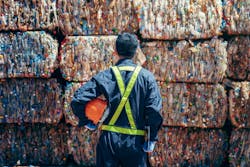Sustainability: Capture Recycling Business Opportunities
Do you know how frustrating it is trying to remove grocery store labels from plastic headed for recycle? Sometimes even soaking overnight is hopeless. And there is that glue residue that survives steaming in a dishwasher at 246oF. If this is a problem for consumers, I doubt the recycler will remove the remnants of the label and the glue. Small wonder that environmental group Beyond Plastics and the Last Beach Cleanup report only 6% of the 40 million tons of plastic collected by consumers is actually recycled (data is from May 9, 2022).
Industry does better than consumers because of the incentive of savings on waste. The largest use of plastic is packaging and the EPA reports only 53.9% is recovered. The U.K. did a study of industrial plastic waste in 2008: 58% of waste is from packaging; 10% is from construction; the rest is from a variety of sources. Some 4% of crude goes to plastics: that’s a lot of junk floating on Gilligan’s Island in the Pacific.
What’s even more concerning: the United States burns six times more plastic waste than it recycles, contributing to global warming directly.
Then, there are electrical wastes — heavy metals in batteries, copper in motors, light fixtures, etc., and rare earths and glass. Batteries are a particular worry; the process used currently involves smelting and extraction, expensive and labor-intensive operations. I remember interviewing once with a company in Utah endeavoring to extract these heavy metals. They were discouraged because battery makers made their product components extremely difficult to separate: people are working on it. The one bright spot is the recovery of lead from batteries: 99% efficiency.
Other sources of waste include plating baths for coating metal surfaces. This recovery technology has been around for 40 years and involves ion-exchangers and smelting.
The overall recovery of ferrous metals, as reported by the EPA, is only 27.8% (2018); however, 70.9% of metal in cans is recycled. Note there is an effort by can users to make metal recovery easier (references here and here).
The EPA reports that 67% of non-ferrous metals were recovered in 2018. Obviously, metals like copper, silver, nickel and others offer a higher price value than iron (reference).
Glass recovery is only 31.3% with the majority going to landfill. Glass is energy-intensive to manufacture but easily recoverable if handled carefully during use. Obviously, glass represents a great opportunity for savings.
Perhaps the greatest challenge in recovering metals is cleaning them before recycling. Too often, failing to do so sets up a corrosion scenario that can make recycling impractical.
Note materials that may be exposed to radiation, such as in a nuclear plant, must be separated and handled carefully. In the 1990s, the French invented a process called vitrification whereby wastes are encased in glass and stored in drums. This process is very expensive but is used today in the nuclear industry.
Recycling is much worse for rare earth elements (REEs) critical for the chip industry. According to an article in 2018, only 1% of REEs are recovered and reused. Reference: “Recycling of the rare earth,” by Simon M. Jowitt, Timothy T.Werner, Zhehan Weng, Gavin Mudd, Elsevier, March 2018. This has been a worry of national security for over 30 years. China owns 90% of global production of REEs (Tahuti Global, April 2022). This is one of the problems the Biden administration has been working on since before the war in Ukraine began.
Then, there’s real estate. One source put the price of industrial real estate at $145/ft2 (Q4 2020). At a plant built in the late 1940s, I measured the boneyard at 7% of a 660,000-ft2 facility, that’s $6 million in wasted plant footprint.
Composite materials, e.g., fiberglass, poses additional problems. Epoxies age, absorb chemicals that can be difficult to remove; they are environmentally toxic.
The Netherlands found it could make park benches and such out of the fiberglass recovered from wind turbine blades. Typically, blades last 12–20 years, depending on standards. Here in the United States, recyclers are looking at ways to re-task blades to avoid burning them for fuel or land-filling them.
Clearly, as an industry, we can do better. The prospects of future mining operations are bleak. Transportation costs, mining costs and scarcity are making it harder to supply virgin materials. Someday, scarce minerals won’t be readily available. In addition, recycling represents a business opportunity between recyclers and manufacturers to assure key supplies.
About the Author

Dirk Willard
Contributing Editor
DIRK WILLARD is a former ASBPE award-winning columnist for Chemical Processing's Field Notes column. During his 10+ years as a contributing editor for CP, he wrote hundreds of valuable and insightful pieces on design and operational issues. He retired in 2023.
